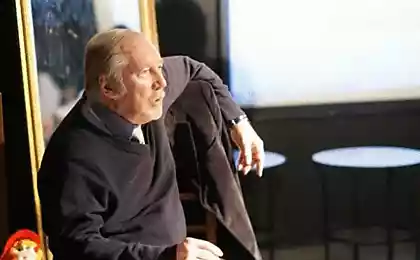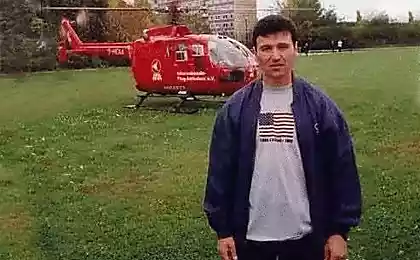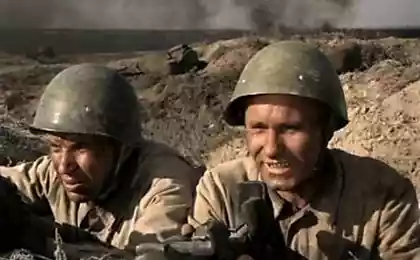866
10 scientific explanations for near-death
Seventy one million eight hundred fifty four thousand four hundred ninety four
There is a very good reason why all people have a healthy curiosity about clinical death. Death is the only experience that we all eventually attain. Science has done a lot of attempts trying to describe the phenomenon of clinical death, spoke of so many unrelated people.
The temporo-parietal node might be responsible for the experience of "out of body"Among the most common elements of clinical death have the distinct feeling that the individual leaves its mortal body. Those who have had the experience of "leaving the body", often report that during clinical death swam around and saw my body and people around him. There were also reports that during out-of-body that people can identify objects and events. Studies have shown that all this can answer the temporo-parietal site of the brain.
The temporo-parietal node is responsible for the integration of data collected by the senses and the body, shaping the perception of the person. When this part of the brain is damaged, quite possibly, appears the experience of leaving the body, which is spoken by so many people.
Although this experience can be incredibly vivid and real, within the scientific studies were able to reproduce this phenomenon without bringing the person to the point of death, but just electrically stimulating the temporal-parietal site of the brain.
Excess carbon dioxide creates "light at the end of the tunnel"Almost every person who experienced a near-death experience, says bright white light and a tunnel, supposedly leading to the afterlife. White light is often associated with the spirit world, mentioning the sense of calm and tranquility.
A 2010 study involving patients with heart attack, found a link between this type of clinical death and the level of carbon dioxide in the blood. Of 52 cardiopatico 11 were clinically dead. The CO2 level in the blood of these patients was significantly higher than in patients who did not mention about near-death experiences. Scientists came to the conclusion that the excess carbon dioxide in the bloodstream may significantly affect vision, resulting in tunnel and bright light.
The lack of oxygen in the brain leads to hallucinational clinical death involves the emergence of a long-dead friends and relatives, sometimes even "escorted" the patient to the afterlife. My life flashes before my eyes in the form of memories, and there comes an overwhelming feeling of comfort. However, science has an opinion about why this is happening.
While the excess carbon dioxide affects vision during clinical death, lack of oxygen to the brain complements this. It is well known that oxygen deprivation can lead to hallucinations and even contribute to feelings of euphoria, which is often reported. Although the sample size for the evaluation was not so great, studies have shown that people who reported clinical death during a cardiac arrest, also had a low oxygen level.
Scientists believe that oxygen deprivation can also lead to what people see, if transported to the place where they are surrounded by friends and relatives, long deceased. It's still just a theory, however, other studies show that the lack of oxygen and excess of carbon dioxide, as well as blocking the blood flow of the brain due to a heart attack — all these factors play a role in the emergence of hallucinations.
Under extreme stress the brain releases endorphinergic time there was a theory that the dying brain can release endorphins and other chemicals due to severe stress. Although the idea that the depth of near-death experiences can be associated with endorphins, was a little cracked, it can easily explain why many people who have experienced clinical death, nor fear or anxiety about what is happening.
The release of morphine-like chemicals during high stress was first suggested by the neuropsychologist Daniel Carr, trying to explain near-death experiences in General, but it turned out that it better explains the tranquility and absence of pain or anxiety in situations in which the body is exposed to extreme influences. Thus, although one would expect that in a state close to death, we need to experience the "incredible pain and terror, the nde surprises us with pleasure, calm and peace," and it's thanks to the release of chemicals in the brain.
Brain activity off the charts before smartypaginate sensory perception — a shared moment of clinical death, and one recent study shows that a kind of supersensitive perception may be caused by a significant surge of activity of the brain in the dying moments. The study was conducted on rats and did not differ a special scale, so some members of the scientific community does not accept the results, but lead author Jimo Bordzhigin believes that they demonstrate the biological basis of nde.
The study is based on the implantation of electrodes into the brain of rats, so researchers can study the levels of brain activity at the moment of death. The results showed that rats were in the so-called "gipertoniya", which was accompanied by increased sensitivity, which many also associate with clinical death. He Bordzhigin notes that the increased activity of consciousness is higher when the heart stops — within the first 30 seconds.
The truth of the sensations can be confused with anesthesia oznayomlennya death "out of body" may be associated with another reason, apart from the damage to the temporo-parietal junction. Many cases can be nothing other than consciousness under anesthesia. Although consciousness under anesthesia remains quite rare (one of the thousands of people saves it), it is possible that those who believe that have had near-death experiences, actually built a false memory in the mind.
This can be the main reason that pam Reynolds near-death experience which is often referred to, could remember so many details of the operation. Reynolds was able to describe the shape of a saw used to cut her skull, and even remembered that the doctors listened to the song "Hotel California" during the operation.
Clinical death Reynolds looks a powerful testimony of near-death experiences that include authentic perception, but all she could remember happened when she was alive but under anaesthesia. Thus, although Reynolds might have thought that at the point of death, skeptics believe that it was more likely one of those rare cases in which the patient remains in consciousness under anesthesia.
Altered or distorted sense of time plays an important aldoclor Eben Alexander, a neurosurgeon, wrote a book with a detailed description of his personal experiences of clinical death, which occurred when he was in a coma due to meningitis. According to Alexander, a near-death experience lasted a few days and would occur when the cortex of his brain was in a coma, that was ironic, considering how many sensory details he experienced — usually it is the bark. This led him to the conclusion that the material causes of his experiences were not at all.
While the personal opinion of a neurosurgeon about the clinical death has resulted in sensational headlines, Dr. Oliver sacks, also a Professor of neurology at the Medical school at new York University, offered a fairly simple explanation of the experiences of Dr. Alexander.
According to Sachs, "a mind-bending journey to the bright light and beyond, a full-scale clinical death can last 20-30 seconds, although it seems that it takes more time. Subjectively, during such a crisis, the very notion of time may seem variable or meaningless. One of the most plausible hypotheses in the case of Dr. Alexander is that his last feelings were not in the coma, and when he came out of the coma and his cortex was returning to its proper functioning. It is curious that he did not take this simple and natural explanation, but rather supernatural."
Hallucinations and perceptions share the same system mazgabarita near-death experiences quite often, recall that it all seemed very real — in some cases even more real than anything they had ever experienced before. Although many of them are firmly convinced that what they perceived wasn't just a hallucination, there is a very good reason to distinguish reality from hallucinations is incredibly hard.
According to Oliver sacks, the man who survived clinical death, all can be considered real and it will seem so, and not without reason: "the Main reason that hallucinations — whatever their cause and nature, seem real, is that they involve the same systems of the brain that and ordinary perception. When I say hallucinations, auditory aktiviziruyutsya way; when someone sees a person aktiviziruyutsya region, which in normal conditions are responsible for the identification of individuals".
Death experiences can be caused by epileptic activity in the temporal Doshu while ecstatic seizures are quite rare and occur in a small percentage of the population affected by temporal lobe epilepsy, epileptic spike activity in the temporal lobe leads to the fact that during clinical death, people begin to see God or heaven. A study conducted by Orrin Devinsky, allowed him and other scientists "to conduct clinical and EEG video-monitoring patients when they are in an enthusiastic or ecstatic feelings, and thus to observe the exact alignment of their teofani with seizure activity in the temporal foci (almost always right)".
Historical figures, among them Fyodor Dostoyevsky, and Joan of Arc, believed to be during temporal lobe epilepsy were included in a sense of ecstasy and felt the presence of something otherworldly. It is possible that those who had near-death experiences, had a similar epileptic activity in the temporal lobes.
By the way, descriptions of ecstatic feelings Dostoevsky is very similar to the descriptions of the experiences of clinical death.
Neuroscience and religion do not contradict one drugiot there have been numerous studies of near-death experiences during clinical death, scientists do not reject the totality of all experience, as a simple result of the normal neurological functions. There is a famous case of Mary, the migrant workers who have experienced clinical death. She allegedly left her body and went to the window outside his room when he saw a tennis Shoe on the step through the window of the third floor. The social worker not only found a Shoe, but found that there was no way to know about her whereabouts.
Another famous near-death experience described by Dr. Tony Cicoria, who was struck by lightning in 1994. A few weeks later after hitting Dr. Cicoria, who had a doctorate in neuroscience, suddenly felt the desire to play and write music. He has changed thanks to the experienced and, in his own words, saw "no distinction between religion and neuroscience — if God works on the person or in the person, He can do it through the nervous system, through a separate part of the brain or in the spiritual sense and faith."
However, while the exact answer to the question of clinical death is not, you may choose any of the options.published
Source: hi-news.ru
There is a very good reason why all people have a healthy curiosity about clinical death. Death is the only experience that we all eventually attain. Science has done a lot of attempts trying to describe the phenomenon of clinical death, spoke of so many unrelated people.
The temporo-parietal node might be responsible for the experience of "out of body"Among the most common elements of clinical death have the distinct feeling that the individual leaves its mortal body. Those who have had the experience of "leaving the body", often report that during clinical death swam around and saw my body and people around him. There were also reports that during out-of-body that people can identify objects and events. Studies have shown that all this can answer the temporo-parietal site of the brain.
The temporo-parietal node is responsible for the integration of data collected by the senses and the body, shaping the perception of the person. When this part of the brain is damaged, quite possibly, appears the experience of leaving the body, which is spoken by so many people.
Although this experience can be incredibly vivid and real, within the scientific studies were able to reproduce this phenomenon without bringing the person to the point of death, but just electrically stimulating the temporal-parietal site of the brain.
Excess carbon dioxide creates "light at the end of the tunnel"Almost every person who experienced a near-death experience, says bright white light and a tunnel, supposedly leading to the afterlife. White light is often associated with the spirit world, mentioning the sense of calm and tranquility.
A 2010 study involving patients with heart attack, found a link between this type of clinical death and the level of carbon dioxide in the blood. Of 52 cardiopatico 11 were clinically dead. The CO2 level in the blood of these patients was significantly higher than in patients who did not mention about near-death experiences. Scientists came to the conclusion that the excess carbon dioxide in the bloodstream may significantly affect vision, resulting in tunnel and bright light.
The lack of oxygen in the brain leads to hallucinational clinical death involves the emergence of a long-dead friends and relatives, sometimes even "escorted" the patient to the afterlife. My life flashes before my eyes in the form of memories, and there comes an overwhelming feeling of comfort. However, science has an opinion about why this is happening.
While the excess carbon dioxide affects vision during clinical death, lack of oxygen to the brain complements this. It is well known that oxygen deprivation can lead to hallucinations and even contribute to feelings of euphoria, which is often reported. Although the sample size for the evaluation was not so great, studies have shown that people who reported clinical death during a cardiac arrest, also had a low oxygen level.
Scientists believe that oxygen deprivation can also lead to what people see, if transported to the place where they are surrounded by friends and relatives, long deceased. It's still just a theory, however, other studies show that the lack of oxygen and excess of carbon dioxide, as well as blocking the blood flow of the brain due to a heart attack — all these factors play a role in the emergence of hallucinations.
Under extreme stress the brain releases endorphinergic time there was a theory that the dying brain can release endorphins and other chemicals due to severe stress. Although the idea that the depth of near-death experiences can be associated with endorphins, was a little cracked, it can easily explain why many people who have experienced clinical death, nor fear or anxiety about what is happening.
The release of morphine-like chemicals during high stress was first suggested by the neuropsychologist Daniel Carr, trying to explain near-death experiences in General, but it turned out that it better explains the tranquility and absence of pain or anxiety in situations in which the body is exposed to extreme influences. Thus, although one would expect that in a state close to death, we need to experience the "incredible pain and terror, the nde surprises us with pleasure, calm and peace," and it's thanks to the release of chemicals in the brain.
Brain activity off the charts before smartypaginate sensory perception — a shared moment of clinical death, and one recent study shows that a kind of supersensitive perception may be caused by a significant surge of activity of the brain in the dying moments. The study was conducted on rats and did not differ a special scale, so some members of the scientific community does not accept the results, but lead author Jimo Bordzhigin believes that they demonstrate the biological basis of nde.
The study is based on the implantation of electrodes into the brain of rats, so researchers can study the levels of brain activity at the moment of death. The results showed that rats were in the so-called "gipertoniya", which was accompanied by increased sensitivity, which many also associate with clinical death. He Bordzhigin notes that the increased activity of consciousness is higher when the heart stops — within the first 30 seconds.
The truth of the sensations can be confused with anesthesia oznayomlennya death "out of body" may be associated with another reason, apart from the damage to the temporo-parietal junction. Many cases can be nothing other than consciousness under anesthesia. Although consciousness under anesthesia remains quite rare (one of the thousands of people saves it), it is possible that those who believe that have had near-death experiences, actually built a false memory in the mind.
This can be the main reason that pam Reynolds near-death experience which is often referred to, could remember so many details of the operation. Reynolds was able to describe the shape of a saw used to cut her skull, and even remembered that the doctors listened to the song "Hotel California" during the operation.
Clinical death Reynolds looks a powerful testimony of near-death experiences that include authentic perception, but all she could remember happened when she was alive but under anaesthesia. Thus, although Reynolds might have thought that at the point of death, skeptics believe that it was more likely one of those rare cases in which the patient remains in consciousness under anesthesia.
Altered or distorted sense of time plays an important aldoclor Eben Alexander, a neurosurgeon, wrote a book with a detailed description of his personal experiences of clinical death, which occurred when he was in a coma due to meningitis. According to Alexander, a near-death experience lasted a few days and would occur when the cortex of his brain was in a coma, that was ironic, considering how many sensory details he experienced — usually it is the bark. This led him to the conclusion that the material causes of his experiences were not at all.
While the personal opinion of a neurosurgeon about the clinical death has resulted in sensational headlines, Dr. Oliver sacks, also a Professor of neurology at the Medical school at new York University, offered a fairly simple explanation of the experiences of Dr. Alexander.
According to Sachs, "a mind-bending journey to the bright light and beyond, a full-scale clinical death can last 20-30 seconds, although it seems that it takes more time. Subjectively, during such a crisis, the very notion of time may seem variable or meaningless. One of the most plausible hypotheses in the case of Dr. Alexander is that his last feelings were not in the coma, and when he came out of the coma and his cortex was returning to its proper functioning. It is curious that he did not take this simple and natural explanation, but rather supernatural."
Hallucinations and perceptions share the same system mazgabarita near-death experiences quite often, recall that it all seemed very real — in some cases even more real than anything they had ever experienced before. Although many of them are firmly convinced that what they perceived wasn't just a hallucination, there is a very good reason to distinguish reality from hallucinations is incredibly hard.
According to Oliver sacks, the man who survived clinical death, all can be considered real and it will seem so, and not without reason: "the Main reason that hallucinations — whatever their cause and nature, seem real, is that they involve the same systems of the brain that and ordinary perception. When I say hallucinations, auditory aktiviziruyutsya way; when someone sees a person aktiviziruyutsya region, which in normal conditions are responsible for the identification of individuals".
Death experiences can be caused by epileptic activity in the temporal Doshu while ecstatic seizures are quite rare and occur in a small percentage of the population affected by temporal lobe epilepsy, epileptic spike activity in the temporal lobe leads to the fact that during clinical death, people begin to see God or heaven. A study conducted by Orrin Devinsky, allowed him and other scientists "to conduct clinical and EEG video-monitoring patients when they are in an enthusiastic or ecstatic feelings, and thus to observe the exact alignment of their teofani with seizure activity in the temporal foci (almost always right)".
Historical figures, among them Fyodor Dostoyevsky, and Joan of Arc, believed to be during temporal lobe epilepsy were included in a sense of ecstasy and felt the presence of something otherworldly. It is possible that those who had near-death experiences, had a similar epileptic activity in the temporal lobes.
By the way, descriptions of ecstatic feelings Dostoevsky is very similar to the descriptions of the experiences of clinical death.
Neuroscience and religion do not contradict one drugiot there have been numerous studies of near-death experiences during clinical death, scientists do not reject the totality of all experience, as a simple result of the normal neurological functions. There is a famous case of Mary, the migrant workers who have experienced clinical death. She allegedly left her body and went to the window outside his room when he saw a tennis Shoe on the step through the window of the third floor. The social worker not only found a Shoe, but found that there was no way to know about her whereabouts.
Another famous near-death experience described by Dr. Tony Cicoria, who was struck by lightning in 1994. A few weeks later after hitting Dr. Cicoria, who had a doctorate in neuroscience, suddenly felt the desire to play and write music. He has changed thanks to the experienced and, in his own words, saw "no distinction between religion and neuroscience — if God works on the person or in the person, He can do it through the nervous system, through a separate part of the brain or in the spiritual sense and faith."
However, while the exact answer to the question of clinical death is not, you may choose any of the options.published
Source: hi-news.ru
Sales of Tesla electric vehicles increased by 55%
Production of dry construction mixtures: a business plan from A to z























